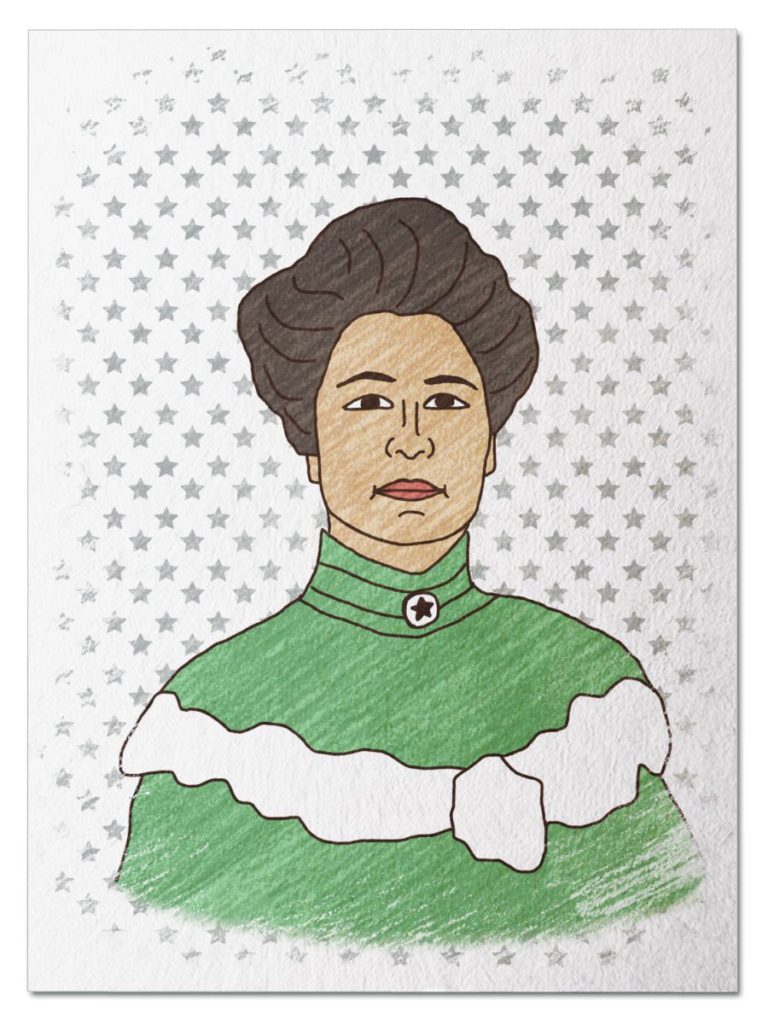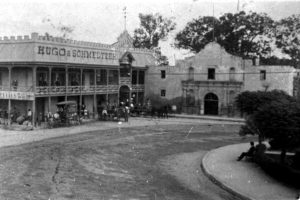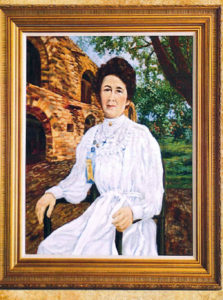
Amazing Artist
She used her knowledge of Texas history as her superpower to save an important part of the Alamo from destruction. While most people thought the building next door looked like an old warehouse, she had a hunch that it was one of the original mission buildings. She became a one woman occupying force locking herself in even as the sheriff cut off electricity, phone service and threatened to arrest her and anyone bringing her food. Travel back to 1908 San Antonio and meed Adina de Zavala…
Her Ruby Shoe Moment
The Power of the Wand
Her Yellow Brick Road
Brains, Heart & Courage
Glinda’s Gallery
Just the Facts
Her Ruby Shoe Moment
Adina de Zavala sat down in the darkness to catch her breath. At 46 years old, she wasn’t used to running up the stairs of dilapidated buildings. It was the evening of February 10, 1908 and she had just locked herself inside the Long Barracks of the San Antonio de Valero Mission (AKA the Alamo). It was a rash decision — she didn’t have any supplies with her. No food. No water. No bedding. No clothes. Only rats for company.

The Alamo, with Long Barracks hidden beneath the warehouse (UTSA Library)
Adina decided that she would stay inside the building until she got her point across. The building didn’t look like anything special at the time. It was an old warehouse and previous home to a grocery store. But Adina was convinced that it was a critical part of the original Alamo. And she was willing to risk her life to preserve it.
It all started two days earlier, when Adina heard rumors that the owners of the Long Barracks (the Daughters of the Republic of Texas) planned to tear down the building and create a memorial park on the site instead. There was also a rumor they would rent the Long Barracks to a vaudeville company, or even sell the site to a hotel group.
 Adina sprang into action. She hired three guards to protect the building, installed a new telephone, and bought all new locks for the building. Then, the sheriff showed up with an injunction — she was not to interfere with the owner’s legal rights over the property. But Adina refused to acknowledge the injunction, much less obey it.
Adina sprang into action. She hired three guards to protect the building, installed a new telephone, and bought all new locks for the building. Then, the sheriff showed up with an injunction — she was not to interfere with the owner’s legal rights over the property. But Adina refused to acknowledge the injunction, much less obey it.
After Adina locked herself inside the building, the sheriff cut off the electricity and telephone. He also threatened to jail anyone who brought food to Adina. Luckily for Adina, her friends didn’t pay any attention to the sheriff either. They provided her with food, blankets, clothing and coffee — she let down a rope, they attached her provisions, and she pulled them up. Eventually, the sheriff gave into pressure and let the electricity be turned back on.
Word spread of Adina’s actions and newspapers around the country picked up the story. Her lawyer presented her demands to the state of Texas. After three days, a compromise was reached — the Long Barracks would be turned over to the governor of Texas. Adina emerged from the building victorious!

The Long Barracks after restoration (The Alamo)
Adina’s efforts led to a restoration of the the Long Barracks in 1912. And workers found evidence that Adina was right. As they stripped away the wooden structure surrounding the Long Barracks, they uncovered the building’s foundation and walled-up arches (where doorways had been). The findings proved definitely that the Long Barracks was one of the original mission buildings.
Thanks to Adina’s quick thinking, the Long Barracks was preserved for future generations. Today, the Alamo is a National Historic Landmark, UNESCO World Heritage Site and a museum visited by millions of people every year.
The Power of the Wand
Adina’s stand-off was the first public act of civil disobedience to save a historic building in America. And she provided a roadmap for future generations of women who were dedicated to the preservation of our nation’s art, architecture, and culture.
Today, teen girls can learn about the historic preservation of buildings and architecture in the Youth Heritage Summit! It’s a summer camp designed for teens — students come to a historic place, complete hands-on activities within the field of preservation, and bring the knowledge they’ve gained back to their community. It is operated by We Are the Next, a nonprofit organization that specializes in educational programs to help teens become more engaged in their communities.
Her Yellow Brick Road
Adina spent many years advocating for the preservation and restoration of the missions in San Antonio. In 1902, Adina formed the “de Zavala Daughters,” an organization dedicated to preserving Texas history. It eventually became a chapter of the Daughters of the Republic of Texas (DRT).
In 1883, the state of Texas bought the Alamo mission chapel from the Roman Catholic Church. But there was more to the complex than just the chapel. The mission also included the monastery and fortress (AKA Long Barracks). At the time, it was owned by a private family and home to a grocery store.

Adina de Zavala (Texas Historical Preservation Society)
Adina convinced then-owner of the Long Barracks, Gustav Schmeltzer, to give the DRT the first option to purchase the property in the event that he ever wanted to sell. It was only a verbal promise, however. In 1903, Adina learned that Schmeltzer was thinking about selling the Long Barracks to hotel company. And she sprang into action.
Adina enlisted the help of a wealthy friend, Clara Driscoll, to purchase the property. Then she lobbied the state to take it over. In 1905, the Texas State Legislature approved funding for the preservation of the Alamo (and reimbursed Driscoll). Then it leased the Alamo to the DRT, which maintained it as a museum. That was a significant accomplishment. But Adina’s work wasn’t done.
 In 1907, a disagreement arose within the DRT regarding the Long Barracks. Was it originally part of the Alamo? Or was it added later? Many thought it was added later and should be demolished as a result. It was ugly, after all.
In 1907, a disagreement arose within the DRT regarding the Long Barracks. Was it originally part of the Alamo? Or was it added later? Many thought it was added later and should be demolished as a result. It was ugly, after all.
Adina was convinced that the Long Barracks were an original part of the Alamo complex. In fact, she thought that it was the oldest structure in San Antonio. Even more — she believed that the famous 1836 Battle of the Alamo took place within its walls. She did extensive research and interview’s soldiers families. And she gathered evidence to prove her point. It was sacred ground.
A grocery company leased the Long Barracks at the time. And it’s lease of the Alamo from the state of Texas was due to expire on February 10, 1908. And it was unclear what would happen then. Would they renew the lease and continue to maintain all parts of the Alamo? Or would they lease only the mission’s chapel and let the Long Barracks go to the highest bidder? Adina wasn’t going to wait to find out.
Brains, Heart & Courage
Adina’s family was considered to be “Texas royalty.” Her grandfather, Lorenzo de Zavala, was a Texas revolutionary and the first Vice President of the Republic of Texas. And she grew up hearing the stories of his bravery and dedication to Texas. She loved history as a child — she read historical books and wrote historical plays with her sister.

Adina De Zavala portrait, commissioned by the Daughters of the Republic of Texas.
Adina was very proud of her Tejana heritage. She was also dedicated to preserving the history of Texas. She emphasize Texas history when she taught elementary school. On her days off from teaching, she collected donations to preserve local historical buildings.
Adina was particularly passionate about preserving the five missions around San Antonio — the Alamo, Concepcion, San Jose, San Juan, and Espada. Before 1900, all the missions were in bad shape. Adina gathered building supplies to help repair them and prevent them from falling down.
Over the years, Adina was involved in the preservation of many buildings in San Antonio, including the the Spanish Governors Palace. She also worked to restore six homes, each representing one of the countries that had control over Texas throughout its history.
Glinda’s Gallery
Just the Facts
- Adina was born on November 28, 1861. Her mother was Irish and her father was Mexican. She was the eldest of six children.
- Adina grew up on a ranch near Galveston and was homeschooled until she was 10 years old. After that, she attended Ursuline Academy in Galveston. Then she went on to Sam Houston Normal Institute in Huntsville and graduated in 1881. She also received a music degree from an academy in Missouri.
- Adina never married. She lived most her adult life in San Antonio and was a teacher for over 20 years.
- Adina she was involved in many historical associations — Texas Historical And Landmarks Association; Texas State Historical Association; Texas Historical Board; Texas Centennial Committee are just a few.
- Adina also wrote about Texas history, including The Story of the Siege and Fall of the Alamo: A Resume in 1911 and History and Legends of the Alamo and Other Missions In and Around San Antonio in 1917.
- Adina died on March 1, 1995, at age 93. As part of her funeral, her casket was carried past the Alamo one last time. In her will, she donated all her assets to charity. Her estate went to the Sisters of Charity of the Incarnate Word for the purpose of establishing a girls’ school.
- Adina’s life’s work was honored by the Texas State Legislature on April 27, 1955. It acknowledged her “major role in preserving the Alamo and the Spanish Governor’s Palace.”
Want to Know More?
The Alamo website (https://www.thealamo.org/remember/structures/buildings/index.html)
https://www.nps.gov/nr/travel/american_latino_heritage/The_Alamo.html
Daughters of the Republic of Texas website (https://www.drtinfo.org)
The Adina Emilia De Zavala Papers are held by the Dolph Briscoe Center for American History at The University of Texas at Austin.
The Adina De Zavala collection is held by the Texas Collection at Baylor University.
Ables, L. Robert. “The Second Battle for the Alamo.” The Southwestern Historical Quarterly 70:3 (1967): 372–413.
Ables, L. Robert. “Zavala, Adina Emilia De.” The Handbook of Texas Online.
De Zavala, Adina. History and Legends of the Alamo and Other Missions in and around San Antonio. San Antonio, 1917.
Fisher, Lewis F. Saving San Antonio: The Precarious Preservation of a Heritage. Lubbock: Texas Tech University Press, 1996.
Zesch, Scott. “Adina De Zavala and the Second Siege of the Alamo.” CRM: The Journal of Heritage Stewardship. Vol. 5 No. 1, Winter 2008 (accessed at https://www.nps.gov/crmjournal/winter2008/article2.html)
